Transfer Letter From One Department To Another
[Your Name]
[Your Address]
[City, State, ZIP Code]
[Email Address]
[Phone Number]
[Date]
[Recipient's Name]
[Recipient's Title]
[New Department Name]
[Company/Organization Name]
[Address]
[City, State, ZIP Code]
Dear [Recipient's Name],
I hope this letter finds you well. I am writing to formally request a transfer from my current position in [Current Department Name] to a new position within the [New Department Name]. I have thoroughly enjoyed my time working in [Current Department Name], but after careful consideration, I believe that my skills and interests align more closely with the responsibilities and opportunities presented in [New Department Name].
As a dedicated employee of [Company/Organization Name] for [Number of Years], I have had the privilege of contributing to the growth and success of our organization. Throughout my tenure, I have gained valuable experience in [mention relevant skills or projects], which I believe will be of great benefit to the [New Department Name]. I am excited about the prospect of bringing my expertise to this new role and making a positive impact within the department.
I have discussed this potential transfer with my current supervisor, [Current Supervisor's Name], and they have expressed their support for my decision. I am committed to ensuring a smooth transition and completing any outstanding projects or responsibilities in my current role before transitioning to the [New Department Name].
I kindly request that you consider my application for this transfer and provide me with the opportunity to discuss my qualifications and enthusiasm for the new role in more detail. I am confident that my background aligns well with the requirements of the [New Department Name], and I am eager to contribute to its ongoing success.
Please let me know if there is a convenient time for us to meet and discuss this transfer further. I appreciate your time and consideration.
Thank you for your attention to this matter. I look forward to the possibility of joining the [New Department Name] and contributing to its continued growth.
Sincerely,
[Your Signature]
[Your Typed Name]
Enclosure: [If applicable, mention any attached documents, such as a current resume or recommendation letters]
Formal Transfer Letter from One Department to Another
Subject: Transfer to New Department
Dear [Employee’s Name],
We are writing to inform you of your official transfer from the [Current Department] to the [New Department], effective [Date]. This decision was made after careful consideration of your skills, performance, and the current needs of the organization.
In your new role, you will report directly to [Supervisor’s Name] and will be responsible for [brief outline of new responsibilities]. We are confident that your expertise will bring valuable contributions to your new team.
Please coordinate with HR to complete all necessary transfer formalities before your effective transfer date. We wish you success in your new department and trust that you will continue to demonstrate professionalism and dedication.
Sincerely,
[Manager’s Name]
Employee Request for Transfer Letter
Subject: Request for Transfer to Another Department
Dear [Manager’s Name],
I am writing to formally request a transfer from my current position in the [Current Department] to the [Desired Department]. Over time, I have developed a strong interest in the work carried out by the [Desired Department], and I believe my skills in [specific skills] align well with their objectives.
This transfer would allow me to apply my experience while also providing me with opportunities for growth. I am confident that this move will benefit both the department and the organization as a whole.
I kindly request your consideration of my application. I am happy to discuss this further and provide any information needed.
Thank you for your time and understanding.
Respectfully,
[Your Name]
Provisional Transfer Announcement Letter
Subject: Provisional Transfer Notification
Dear [Employee’s Name],
This letter serves as a provisional notification regarding your transfer from the [Current Department] to the [Proposed Department]. The transfer is currently under review and is expected to be finalized by [Date].
Please note that this is not a final confirmation but an advance communication to allow you to prepare for possible changes. Formal confirmation will follow once all approvals have been completed.
In the meantime, you should continue with your current duties until further notice. We appreciate your patience and understanding during this transition process.
Regards,
[Manager’s Name]
Official Transfer Approval Letter
Subject: Approval of Department Transfer Request
Dear [Employee’s Name],
We are pleased to inform you that your request for transfer to the [New Department] has been approved. Your transfer will take effect on [Effective Date].
You will report to [Supervisor’s Name] in your new department and will be assigned responsibilities in line with your experience and skills. We encourage you to meet with your new manager to discuss your transition and expectations.
Thank you for your commitment to the organization. We wish you continued success in your new role.
Sincerely,
[HR Manager’s Name]
Casual Transfer Email to Team
Subject: Department Transfer Announcement
Hi Team,
I wanted to share some personal news with all of you. Starting from [Date], I will be moving from the [Current Department] to the [New Department].
It has been a wonderful experience working with all of you, and I truly appreciate the support and collaboration I’ve received here. While I’m excited for this new opportunity, I will definitely miss working alongside you.
Let’s stay in touch, and I hope we’ll continue collaborating across departments in the future.
Best wishes,
[Your Name]
Heartfelt Transfer Farewell Letter
Subject: Thank You and Farewell as I Transfer
Dear Team,
As I prepare to transfer from the [Current Department] to the [New Department], I wanted to take a moment to thank each of you for the experiences, lessons, and friendships I have gained during my time here.
This department has been more than just a workplace; it has been a family. I am grateful for the encouragement, teamwork, and trust I have received. Though I am moving on to a new challenge, the memories and bonds we share will remain with me.
I look forward to seeing you around and collaborating in new ways. Thank you once again for making my time here unforgettable.
With gratitude,
[Your Name]
Simple Transfer Notification Message
Subject: Transfer Notification
Dear [Employee’s Name],
Please be informed that you are being transferred from the [Current Department] to the [New Department], effective [Date]. You will report to [Supervisor’s Name].
HR will contact you with further details regarding the transition process.
Regards,
[Manager’s Name]
Serious Transfer Due to Organizational Needs Letter
Subject: Department Transfer Due to Organizational Needs
Dear [Employee’s Name],
As part of the organizational restructuring initiative, you are being transferred from the [Current Department] to the [New Department], effective [Date]. This decision has been made to ensure optimal utilization of resources and alignment with company goals.
While we understand that this change may require adjustments, we believe that your skills and experience will be invaluable in your new department. We are confident that this transfer will provide both challenges and opportunities for professional growth.
Thank you for your cooperation and continued dedication.
Sincerely,
[Manager’s Name]
What is a Transfer Letter from One Department to Another and Why Do You Need It?
A transfer letter from one department to another is a formal communication issued by an organization to inform an employee of their movement from one department to another.
Its purposes include:
- Documenting the decision officially.
- Providing clarity about effective dates, new roles, and reporting managers.
- Ensuring smooth transitions between teams.
- Recognizing employee requests or organizational requirements.
Such letters protect both employer and employee by establishing a clear record of the transfer.
Who Should Send a Department Transfer Letter?
- HR managers when communicating official approvals.
- Department heads or supervisors when informing employees of organizational needs.
- Employees themselves when requesting transfers.
- Senior management when announcing broader departmental movements.
The sender depends on whether the letter is a request, notification, or approval.
Whom Should a Transfer Letter Be Addressed To?
- Employees being transferred.
- Managers in the receiving department.
- HR teams for record-keeping.
- Sometimes an entire team if the transfer affects workflow.
The recipient always depends on the purpose—whether it’s a request, approval, or general announcement.
When Do You Need to Write a Department Transfer Letter?
- When an employee requests a transfer for personal or professional reasons.
- When management decides to reassign staff due to organizational needs.
- During promotions or role realignments.
- After mergers or restructuring of departments.
- When confirming provisional transfer notifications.
Timing is key—letters should be issued before the effective date.
Requirements and Prerequisites Before Writing a Transfer Letter
- Clear reason for the transfer (employee request, restructuring, etc.).
- Approval from relevant supervisors and HR.
- Effective date of transfer confirmed.
- Identification of the new department head.
- Administrative checks like clearance of pending tasks or handovers.
Having these in place avoids confusion and delays.
Formatting Guidelines for Department Transfer Letters
- Length: Usually one page or less.
- Tone: Professional and respectful.
- Style: Formal for official notices, casual for personal messages.
- Structure: Subject, greeting, body (reason + details), closing.
- Mode: Printed letter for HR files, emails/messages for quick communication.
- Etiquette: Ensure politeness and avoid negative language.
Common Mistakes to Avoid in Transfer Letters
- Leaving out the effective date of transfer.
- Using vague reasons without explanation.
- Not mentioning the reporting manager in the new department.
- Overly emotional or unprofessional tone.
- Sending the letter too late, leaving no time for transition.
Pros and Cons of Sending Transfer Letters
Pros:
- Creates a formal record.
- Ensures transparency and fairness.
- Clarifies expectations for both employee and management.
- Provides motivation and recognition in some cases.
Cons:
- Can cause stress if not handled sensitively.
- May lead to resentment if perceived as forced.
- Adds administrative work if poorly managed.
Tricks and Tips for Writing Effective Transfer Letters
- Always specify what, where, and when clearly.
- Personalize by addressing the employee by name.
- Keep the tone positive, even when transfers are organizationally required.
- Send copies to HR and relevant supervisors.
- Use templates for consistency but customize for the situation.
After Sending a Transfer Letter: What to Do Next
- HR should update personnel files and payroll systems.
- The employee should complete handover tasks.
- Managers should arrange a smooth onboarding in the new department.
- Teams should be notified to ensure proper communication.
- Follow up with the employee to ensure successful adjustment.
Compare and Contrast: Transfer Letters vs. Promotion Letters
- Transfer Letters: Focus on departmental movement without necessarily involving a change in rank or pay.
- Promotion Letters: Highlight advancement in role, responsibilities, and often salary.
- Similarities: Both formal communications, both require HR involvement.
- Differences: Promotion is reward-oriented, while transfer can be employee-driven or organization-driven.

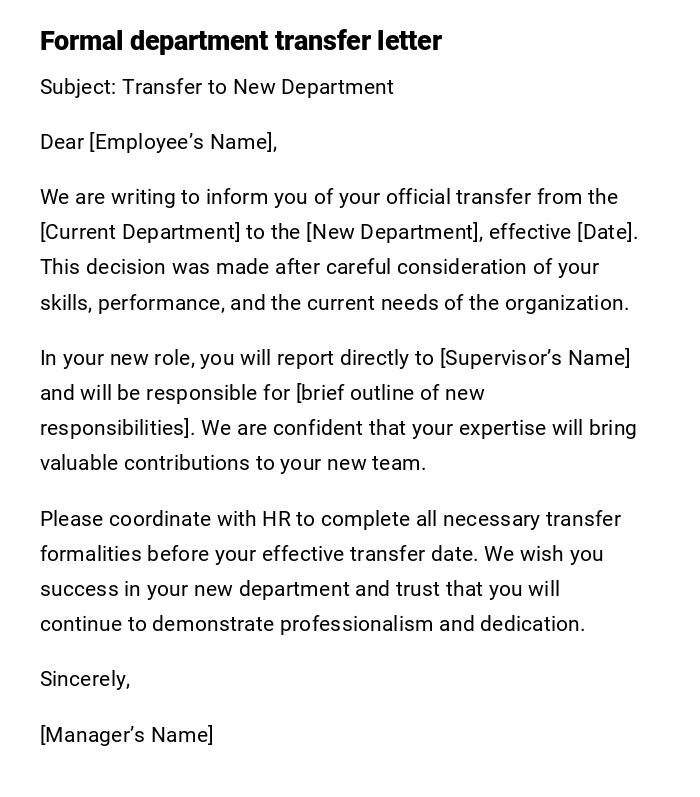
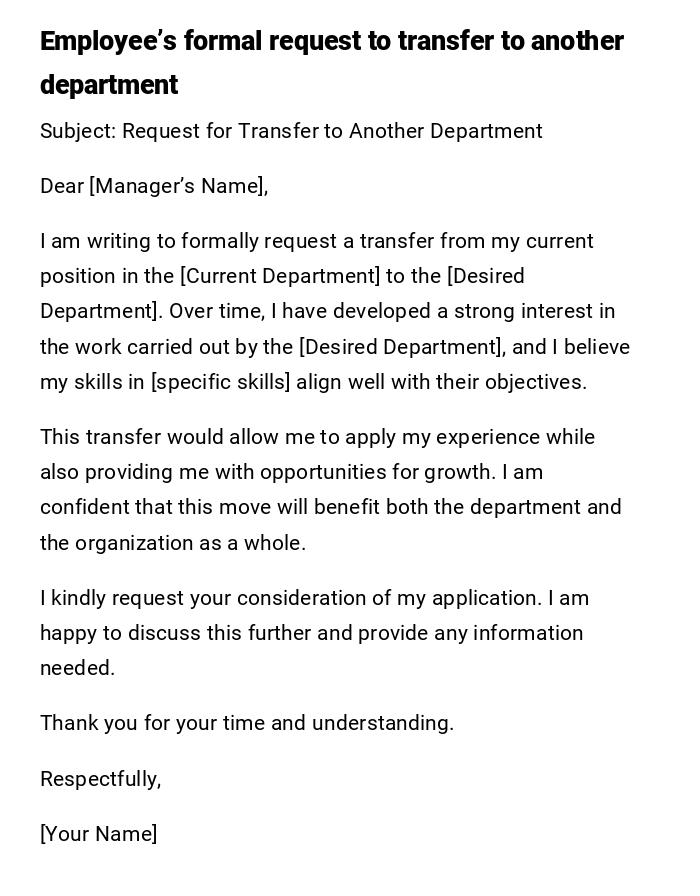
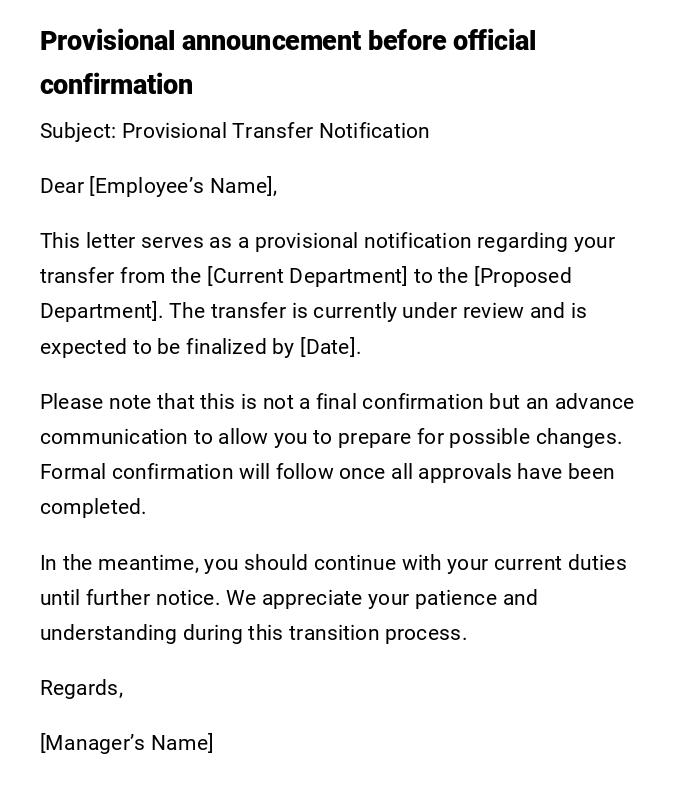
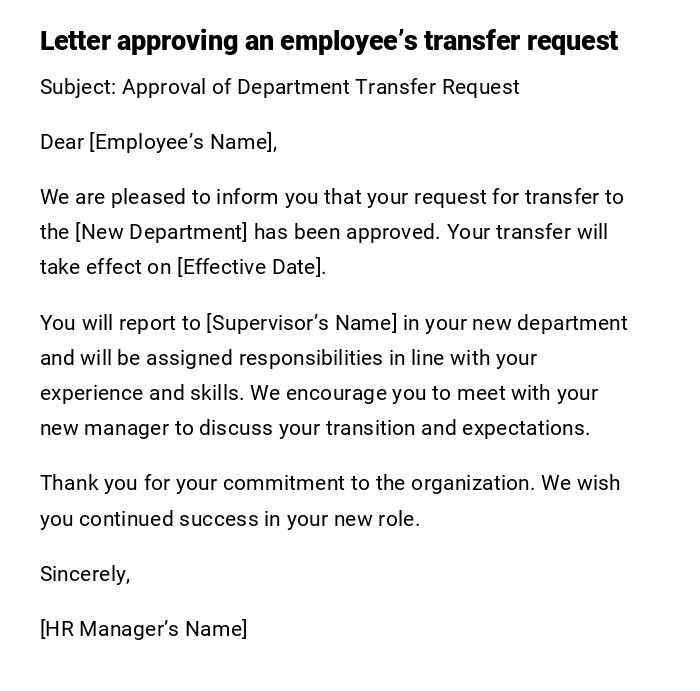
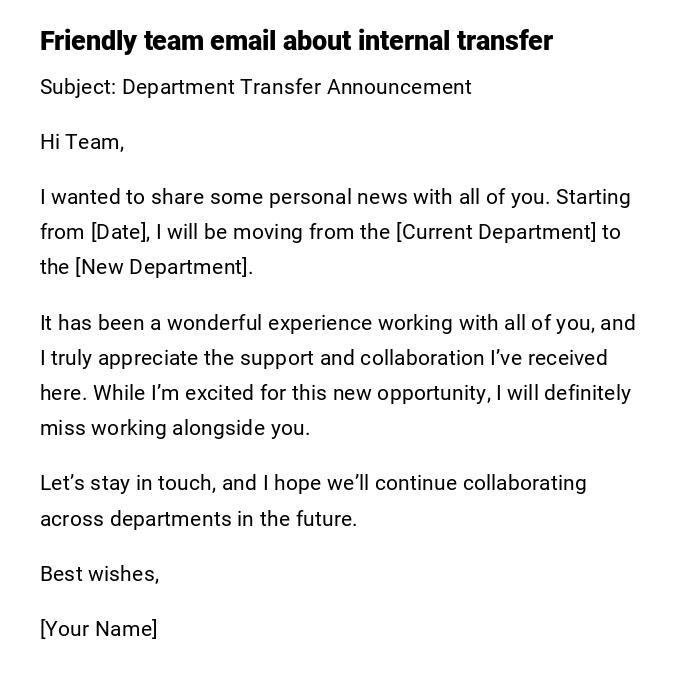
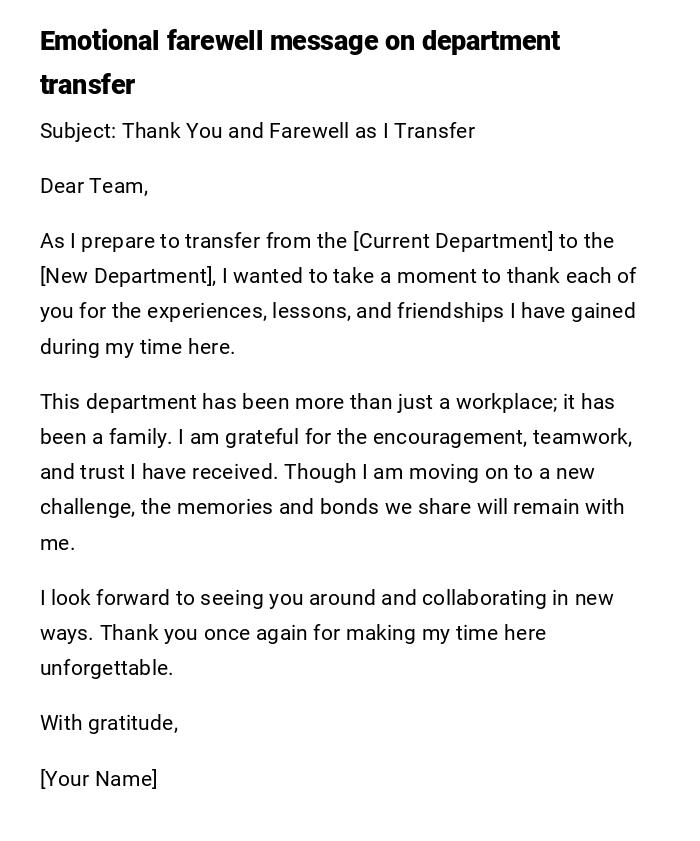
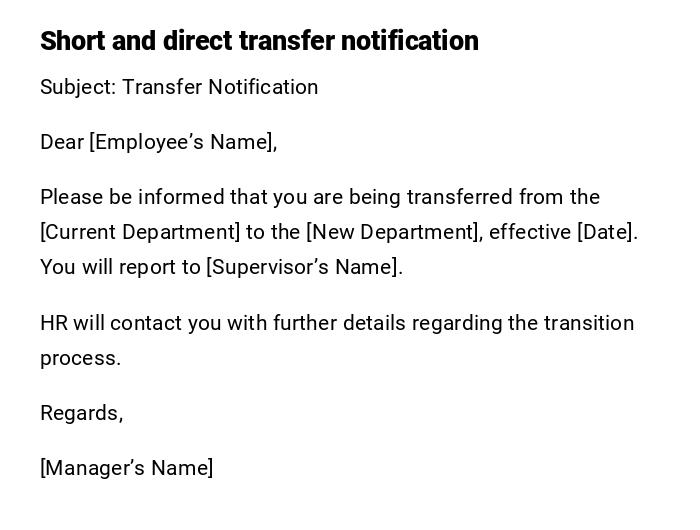
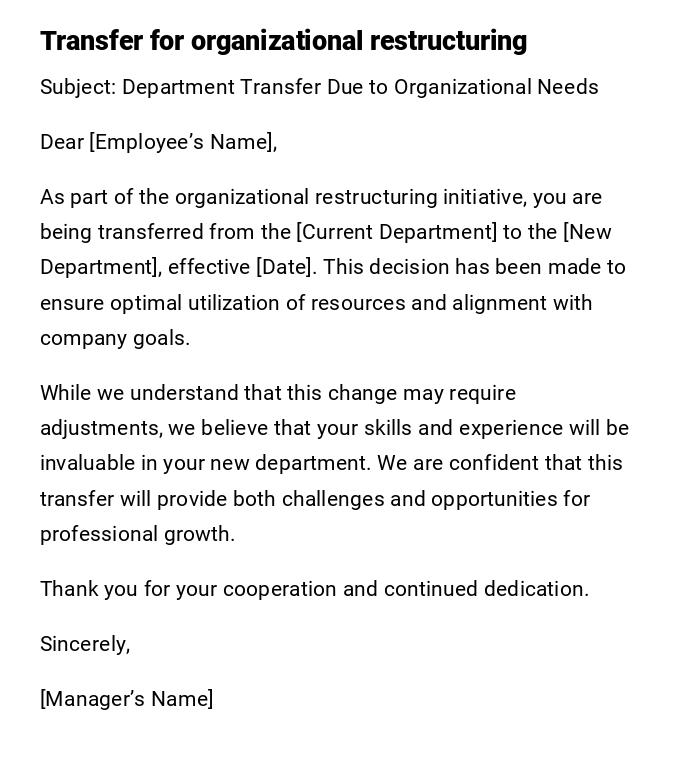

 Download Word Doc
Download Word Doc
 Download PDF
Download PDF